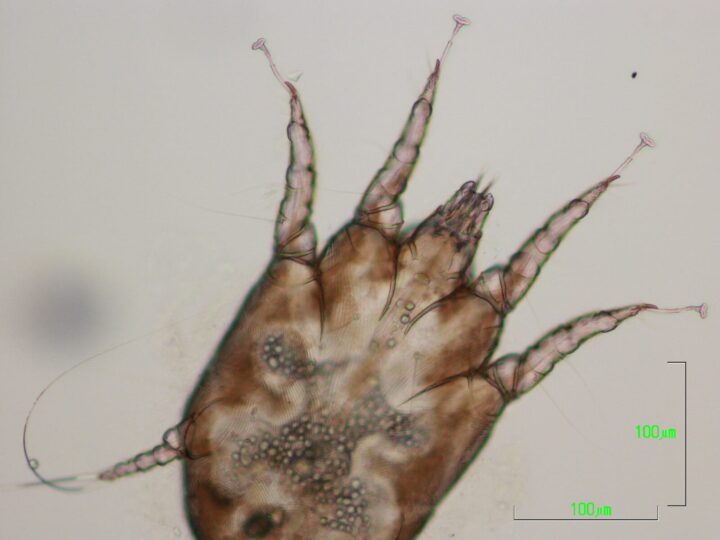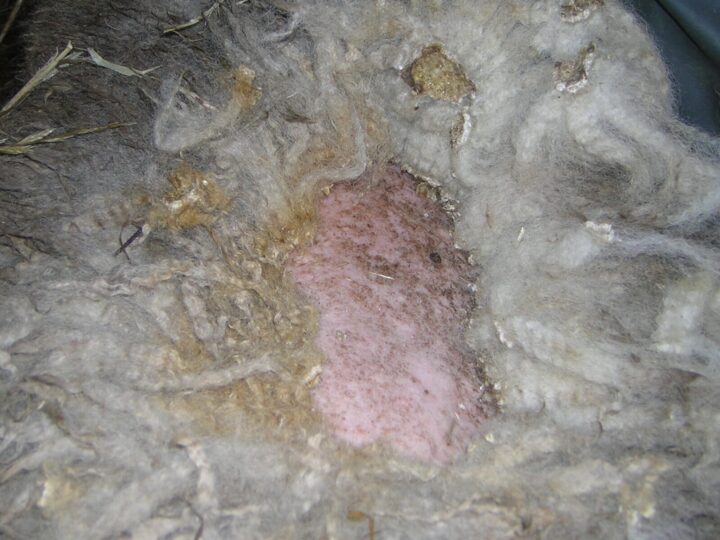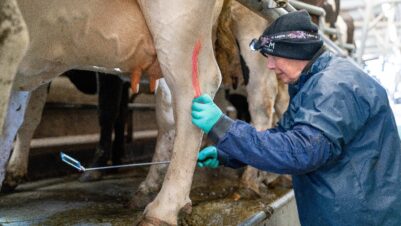Sheep scab, caused by Psoroptes ovis, has been recognised since the earliest records of sheep keeping, including references in the Old Testament scriptures (Figure 1). Before 1000 AD, there are references to Welsh chieftains regulating to prevent the sale of scabby sheep and enforce quarantine of infected areas. Several centuries later, the mortality rate from sheep scab was a major contribution to the economic recession that preceded the Black Death in the late medieval period, as sheep deaths starved the wool industry of its key ingredient.
This article will review the clinical signs, diagnosis and treatment for sheep scab, in addition to calling for a collaborative approach to effective control measures.

Clinical signs of sheep scab
The clinical signs of classic cases of sheep scab are well documented and result from an allergic dermatitis triggered by faecal products of the scab mite. Often one of the earliest indications of sheep scab is signs of pruritus with dirty marks over the shoulders (Figure 2). As the disease progresses there is wool loss, spreading from the shoulders down the flanks and caudally as the mite population expands and spreads across the sheep (Figure 3). Death from secondary infection, exposure or starvation, when the itching becomes all-consuming, can follow if sheep are not treated.
Any sheep, especially in the warm, dry months and following shearing, may enter a latent infestation period where they demonstrate few, if any, clinical signs
In addition, it is recognised that in some flocks, particularly extensive flocks of hill breeds, chronically infested sheep may harbour low levels of scab mites, to which they have developed a level of tolerance. In such cases, they do not look like scabby sheep with continual itching or wool loss. However, when moved to more intensive settings, their offspring will bring mites with them, introducing scab to naïve sheep causing mite numbers to rise rapidly and classic clinical signs to emerge (Spence, 1951).
Furthermore, any sheep, especially in the warm, dry months and following shearing, may enter a latent infestation period where they demonstrate few, if any, clinical signs. During this period, mites become very much less active and “retreat” to the shelter of ear canals and skinfolds to prevent them succumbing to desiccation until conditions once more are favourable for reproduction (Spence, 1949). The final survival tool mites possess, which facilitates dissemination within and between flocks, is their ability to survive off-sheep for up to 17 days.


Diagnosing sheep scab
A negative skin scrape has repeatedly been shown to have poor specificity for confirming a flock to be free of scab
Diagnosis can be straightforward if live mites are detected on a skin scrape; however, a negative skin scrape has repeatedly been shown to have poor specificity for confirming a flock to be free of scab (Hamer et al., 2019; Crawford et al., 2024). However, an ELISA-based blood test is now commercially available, which helps to identify flocks infested with scab before overt lesions develop and the mite population expands sufficiently for detection using skin-scrape techniques (Nunn et al., 2011).
As the ELISA-based blood test is based on antibody production, care should be taken to ensure sufficient time elapses between exposure and blood testing to allow the antibody response to develop. Due to the highly contagious nature of the infestation (whereby more than half the sheep in a batch are already infested at the point when clinical signs are obvious), the test can be utilised at flock level, with statistically based sampling of 12 sheep suggested from any batch, rather than needing to test every sheep.
The test has been deployed successfully to “get ahead” of outbreaks – speeding up identification of scab and minimising onward transmissions, and thus reducing the number of flocks that are treated, saving time, cost and the environmental impact of treatment. Plunge dipping, with the organophosphate diazinon, is considered the treatment of choice following the emergence of resistance to all macrocyclic lactones (MLs) in recent years (Sturgess-Osborne et al., 2019).
Treating sheep scab
Scab was eradicated in Great Britain (GB) in the early 1950s, but reintroduced in the early 1970s, with the best evidence surmising this occurred through sheep imported from Ireland. It took over a year before it was recognised that scab had re-entered GB, by which time it had become established in the national flock. Compulsory dipping was introduced; however, scab was not eradicated. Compulsory dipping ended in 1992, in part due to concerns about the potential risk to human health through exposure to dip products.
Plunge dipping, with the organophosphate diazinon, is considered the treatment of choice following the emergence of resistance to all macrocyclic lactones
At this time, the first injectable ML product authorised for scab control in the UK, which became available, was ivermectin (two injections one week apart), followed by doramectin by a single injection, but at a higher dose than authorised for gastrointestinal nematode (GIN) treatment. Finally, in 1999, moxidectin was introduced (single dose of 1 percent solution for protection, two doses of 1 percent solution 10 days apart for treatment or a single dose of 2 percent solution for extended-duration protection).
These treatments provided a viable, practical and attractive alternative to dipping, with reduced demand on manpower and less stress on the sheep, and obviated the need to bring the sheep to a suitable dipping bath. Uptake was widespread and rapid; however, due to the differing dose rates (doramectin) and dose frequencies (ivermectin and moxidectin 1 percent) required for scab control compared to their authorised doses for GIN control, scab mites were repeatedly exposed to sub-lethal doses. Resistance among sub-populations of scab mites to all the injectable MLs has now been demonstrated (Sturgess-Osborne et al., 2019); however, to date, there is no evidence of resistance among the scab mite populations in the UK to diazinon.
Where there is a treatment failure following dipping, this is down to poor technique, with a failure to correctly top the dip-bath up and a failure to retain sheep in the bath for a full minute (ensuring their heads are fully immersed twice during that period) commonly identified. Useful industry guidelines, produced by the Sustainable Control of Parasites in Sheep (SCOPS), exist to guide best practice in the use of sheep dips along with steps to take in the event of a suspected treatment failure.
Current situation in Great Britain
While calls persist among some for a return to compulsory dipping, this is unlikely to happen. Instead, today, evidence from the four home nations suggests that a targeted, local approach can be effective in achieving control of scab. In a recent project in Northern Ireland using the ELISA blood test, scab was identified in 20 out of 25 flocks returning a negative skin scrape, including seven flocks with no discernible signs of scab, but which were contiguous with an infested flock or used a common grazing area where scab-infested sheep had grazed (Crawford et al., 2024). This disclosure allowed targeted treatment of the flocks and prevented wider dissemination of the disease that could have occurred if only visual cues had been used, and scab had been erroneously ruled out.
Under the Welsh scab eradication programme, once an infested flock is identified, trusted facilitators work to identify, risk-assess and test contiguous flocks. This is an extension of pilot work which highlighted the need for trusted individuals to engage farmers and the distrust of state officials (Paton et al., 2022), as has also been recognised in Northern Ireland (Crawford et al., 2023). Dipping using trained, standardised contract mobile dippers is then coordinated to ensure that all infested and at-risk flocks are fully treated.
How can we retain a focus in the mind of farmers to consider what they cannot see as being as big a risk, or maybe a bigger risk, to their stock’s health than those things that they can see?
On the islands of Lewis and Harris, systematic blood testing and dipping has been undertaken to identify and then treat the infestation. In addition to seeing a reduction in scab levels, there was a positive response from the crofters to the facilitation they received in working together to tackle disease in their flocks, rekindling a social spirit that had declined over time from the “old days” of community collaboration (Shortall et al., 2024).
A similar approach, based on testing flocks in geographically defined hotspot areas of England, was undertaken between 2021 and 2023. Over the two years of the project, follow-up testing showed a reduction in scab from approximately 26 percent of flocks on initial testing to 4 percent at follow-up (with, however, some notable regional variation) (Burgess et al., 2024).
Central to the impact of all four schemes are two common threads: demonstrating the presence of disease using modern diagnostic testing and facilitating farmers to work together to optimally treat and prevent scab in a proactive, coordinated and collaborative manner, rather than a reactive approach once scab is evident in a flock.
This approach is not entirely new, but utilised new tools and knowledge. A concerted final push in the late 1940s led to the eradication of scab from GB. This push focused on the recognition that legislation alone achieves very little. Intervention was focused on the areas where the knowledge accrued at that time suggested flocks were chronically infested with scab; engaging farmers whose sheep didn’t look scabby was seen as the key to unlocking scab control.
Final thoughts
As we conclude this brief tour of the recent advances in sheep scab control across the UK, it is worth summarising some lessons we can learn and apply across the infectious disease spectrum.
- Keep an open mind that it could be sheep scab: following the reintroduction of sheep scab, it was allowed to spread from the point of entry and become re-established in the national flock before its presence was detected. This occurred in part through ineffective border controls and a mindset of “it can’t be scab because we have eradicated it” among those vets, farmers and other scientists who saw and investigated itchy sheep in the North West of England for months before they put aside their assumption. How often can we become complacent about biosecurity and narrowed in our diagnostic approach, making assumptions rather than retaining an open mind?
- There may not be dramatic clinical signs: chronically infected flocks can sustain scab mites without showing the dramatic signs commonly associated with scab. The carrier animal is a high risk for any disease control programme. How can we retain a focus in the mind of farmers to consider what they cannot see as being as big a risk, or maybe a bigger risk, to their stock’s health than those things that they can see?
- Collaboration is essential to control: compulsory dipping didn’t work because some couldn’t and some wouldn’t dip every sheep properly. It won’t work again for the same reason. Instead of looking backwards to the “good old days”, how can we take a positive step forward? Including social sciences and, in particular, consideration of how to effect positive behavioural change is essential. With respect to scab, the use of trusted facilitators has been shown to be very effective in engaging reluctant farmers, as well as handling neighbours who just won’t talk or work together, to effectively control scab in local areas (Burgess et al., 2024; Crawford et al., 2024; Paton et al., 2022; Shortall et al., 2024). Join these local efforts up, starting in the hotspots that continually seed scab into the national flock, and there is the basis of national control.







